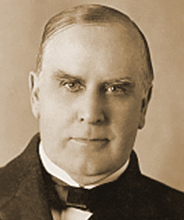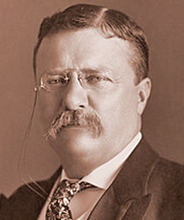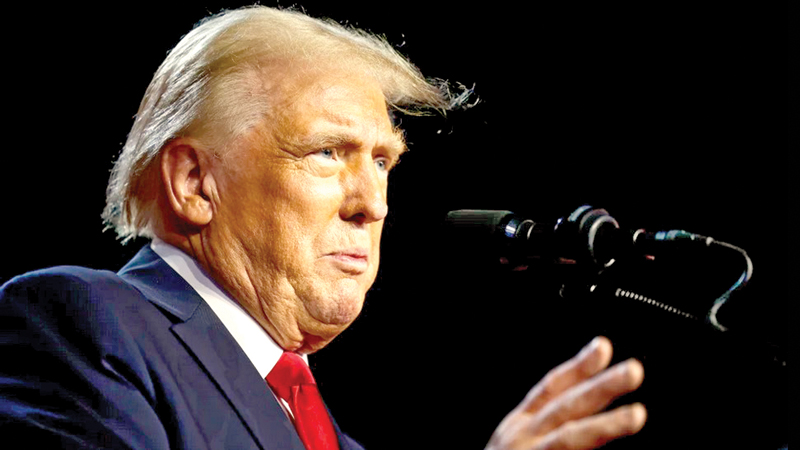All three, Trump, Mckinley and Roosevelt, stand out for advancing US interests aggressively. But McKinley appears to have been a reluctant imperialist
In his inaugural oration, US President Donald Trump hailed William McKinley, who was US President from 1897 to 1901, as his model. Undoubtedly, Trump and McKinley share major attributes, but some historians argue that Trump has taken after Theodore (Teddy) Roosevelt, rather than McKinley. Teddy Roosevelt was President from 1901 to 1909.
All three Presidents stand out for advancing US interests aggressively, but McKinley appears to have been a reluctant imperialist. He even regretted having taken some economic and military decisions seeing their adverse consequences.
In his speech on January 20, Trump picked McKinley for high praise, particularly for raising tariffs “to make America rich”. Trump described McKinley as “a great but highly under-rated” President. He then pledged to change the name of North America’s tallest peak, “Denali” in Alaska, to “Mount McKinley”.

President William McKinley

President Theodore Roosevelt
Trump admired McKinley also for his expansionist policy. It was during McKinley’s tenure, that the US acquired overseas territories, fought and won a war with Spain and attempted to set international norms regarding trade with China. In short, under McKinley, the US emerged on the world stage in new and unprecedented ways giving a foretaste of what was to come after World War II.
In McKinley’s time, US victory in the war with Spain over Cuba saw Spain cede to the US, sovereignty over Guam, Puerto Rico and the Philippines. It paved the way for the US to annex Hawaii, an independent country at that time.
McKinley’s Presidency
Historians are divided on McKinley’s Presidency. He had accomplishments to his credit, but these were as divisive too. Like Trump, McKinley advocated high tariffs. The 1890 Act raising import duties to almost 50 percent bore his name, “McKinley Tariff” as he had initiated the move. For the 1890 Act, he was hailed as “Napoleon of Protection.”
Under Mckinley, immense fortunes were made by a few as the US industrialised under tariff protection. But his high tariff regime also meant higher prices in the domestic market for the common man. Eventually, McKinley spoke up for free trade.
As in Trump’s case, China was high on McKinley’s agenda. The ruling Qing dynasty in China was on its last legs and China had been divided into “spheres of influence” between European powers. American businessmen wanted a share of the Chinese cake. Therefore, on September 6, 1899, McKinley issued the “Open Door Note” demanding that Europeans allow China to become “an open market for the commerce of the world.” He thus secured a share of China for American businesses.
Nationalistic pressure
Historians say that McKinley was actually a “reluctant imperialist.” His aggressive actions were actually a result of domestic nationalistic pressure voiced the press. He later regretted his actions as they were not an unmixed blessing.
He was hesitant to go to war against Spain over Cuba in 1898. The war was fought partly due to the sinking of the US naval ship, USS Maine in Havana harbour allegedly by Spain. Actually, there was no proof that Spain sunk USS Maine. McKinley tried all diplomatic cards before he went to war, but when he finally did, it was because of the hyper nationalistic US media which were baying for blood.
Andrew Jeong, writing on McKinley in the Washington post says that it would be wrong to identify Mckinley with America’s high tariff regime and America’s growth. The US had had high tariffs, before, during and after, McKinley’s term. From 1861 to 1933, average tariffs on dutiable imports were 50 percent. The reason for economic growth in the US was generous credit given by US banks and a spike in infrastructure-related construction. Immigration provided cheap labour. Technological advances also played a part, Jeong said.
High tariff on Cuban sugar was one reason for the war with Spain which was ruling Cuba. The 1894 tariff on Cuban sugar created high tension in US-Spain relations and war followed in 1898.
What Trump has not realised is that McKinley eventually came round to accepting that free trade was the best way to increase US prosperity. As its industrial base expanded, the US needed overseas markets, and high tariff regimes were a barrier to finding such markets.
According to Robert W. Merry, the author of President McKinley: Architect of the American Century, McKinley had enunciated the concept of “trade reciprocity.” In a speech in Buffalo in 1901, McKinley said: “What we produce beyond our domestic consumption we must have a vent abroad. The period of exclusiveness is past. Reciprocity treaties are in harmony with the spirit of the times, measures of retaliation are not.”
According to Dr. Merry, a key distinction between McKinley and Trump is that McKinley used tariff as a negotiating tactic and not as a weapon of first use.
McKinley regretted wars
McKinley regretted fighting a war to seize the Philippines. That war turned out to be expensive.
The Philippine-American War was a conflict between the US and Filipino nationalists that lasted from 1898 to 1902. Filipino nationalists, led by Emilio Aguinaldo, wanted independence from the US. US Admiral George Dewey attacked Manila Bay initiating the war. By the time the Filipinos surrendered in 1902, over 4,200 American soldiers and over 20,000 Filipino fighters lay dead. A disturbed McKinley said that he wished: “Ol’ Dewey had not sailed into Manila Bay.”
It is in this light that Trump should view his plans to annex Greenland and the Panama Canal. Greenland and Panama have rubbished his claims and declared their intention to resist US aggression.
Theodore Roosevelt more like Trump
Theodore (Teddy) Roosevelt, who was the 26th US President from 1901 to 1909, was naturally aggressive, like Trump and unlike McKinley. The then US political establishment saw Roosevelt as dangerous, erratic, and a threat to the stability of the country. Contemporary detractors considered him to be purely transactional, and prone to changing positions on domestic and foreign issues for political rather than substantive reasons.
Mark Twain declared Teddy Roosevelt as “the worst President we have ever had.” According to Twain, Roosevelt was “ready to kick the Constitution into the backyard when it gets in the way.”
But to give the devil its due, like Trump, Roosevelt expanded the powers of the Presidency and of the federal government in support of the public interest. He steered the nation towards an active role in world politics, particularly in Europe and Asia. He won the Nobel Prize for Peace in 1906 for mediating an end to the Russo-Japanese War. Trump had pulled the US out of the Afghanistan quagmire, saving a lot of money. Roosevelt began construction of the Panama Canal.
Roosevelt gave speeches from what he called the Presidency’s “bully pulpit” as Trump announces decisions through midnight tweets. Roosevelt’s aim was to raise public consciousness about issues. He spoke for businesses as well as the common man. As industry developed, competing firms began joining together to form large organisations called “trusts”, that were capable of dominating an entire industry. Roosevelt broke these up through the Sherman Antitrust Act in 1902.
In 1902, when Pennsylvania coal miners went on strike, Roosevelt stepped in to mediate and also threaten to call in the Army to run the mines even as he put pressure on the mine owners to strike a “Square Deal” with the workers. His tactic of “talking soft while carrying a big stick,” worked both in domestic and foreign affairs.
In 1904, responding to the threat of European powers intervening in Latin America, Roosevelt declared what is called the “Roosevelt Corollary to the Monroe Doctrine.” But he intervened in the Russo-Japanese War and brought about a settlement which won him the Nobel Peace Prize in 1906.
In 1903, Roosevelt helped Panama gain its independence from Colombia and cleared the way for the building of the Panama Canal by the US. The canal gave the US the ability to sail quickly between its East and West coasts. Trump is now eying the canal alleging that it is being run by a Chinese company. But Panama, which owns the canal since 1999, is in no mood to surrender its sovereignty over it.
Will Trump send the Marines to seize the canal? And will that ensure peace and stability in Central and South America, the backyard of the US?









